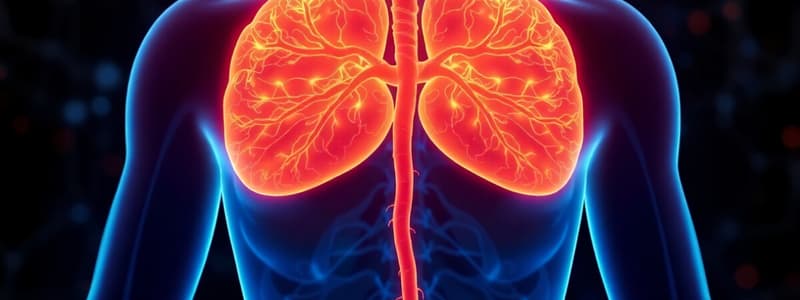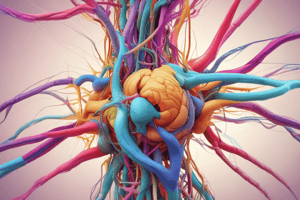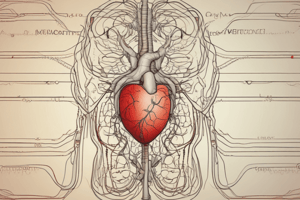Podcast
Questions and Answers
What type of ganglia is located adjacent to the prevertebral ganglia in the sympathetic chain?
What type of ganglia is located adjacent to the prevertebral ganglia in the sympathetic chain?
Which of the following accurately describes the axons of preganglionic neurons in the sympathetic system?
Which of the following accurately describes the axons of preganglionic neurons in the sympathetic system?
What is the primary reason for the divergence of sympathetic efferent neurons?
What is the primary reason for the divergence of sympathetic efferent neurons?
Which structure provides inputs to collateral (prevertebral) ganglia?
Which structure provides inputs to collateral (prevertebral) ganglia?
Signup and view all the answers
Which of the following accurately illustrates the pathway of a preganglionic sympathetic neuron at the level of T1?
Which of the following accurately illustrates the pathway of a preganglionic sympathetic neuron at the level of T1?
Signup and view all the answers
What is the primary function of the sensory (afferent) pathway?
What is the primary function of the sensory (afferent) pathway?
Signup and view all the answers
What distinguishes somatic reflexes from visceral reflexes in terms of the motor (efferent) pathway?
What distinguishes somatic reflexes from visceral reflexes in terms of the motor (efferent) pathway?
Signup and view all the answers
Which type of reflex involves communication with the central nervous system?
Which type of reflex involves communication with the central nervous system?
Signup and view all the answers
Where are the cell bodies of preganglionic neurons located in the long reflex arc?
Where are the cell bodies of preganglionic neurons located in the long reflex arc?
Signup and view all the answers
What role does the myenteric plexus play in the digestive system?
What role does the myenteric plexus play in the digestive system?
Signup and view all the answers
In which part of the nervous system are short reflexes entirely located?
In which part of the nervous system are short reflexes entirely located?
Signup and view all the answers
What is a characteristic of autonomic neurons in the reflex arc?
What is a characteristic of autonomic neurons in the reflex arc?
Signup and view all the answers
Which of the following correctly identifies a function of the submucosal plexus?
Which of the following correctly identifies a function of the submucosal plexus?
Signup and view all the answers
Which neurotransmitter is released by presynaptic adrenergic neurons?
Which neurotransmitter is released by presynaptic adrenergic neurons?
Signup and view all the answers
What type of receptor do cholinergic neurons bind to?
What type of receptor do cholinergic neurons bind to?
Signup and view all the answers
What is the duration of action for acetylcholine (ACh) in the synaptic cleft?
What is the duration of action for acetylcholine (ACh) in the synaptic cleft?
Signup and view all the answers
What type of neuron releases ACh as its neurotransmitter?
What type of neuron releases ACh as its neurotransmitter?
Signup and view all the answers
Which type of cholinergic receptor is located on postganglionic neurons?
Which type of cholinergic receptor is located on postganglionic neurons?
Signup and view all the answers
What is the impact of ACh binding to its receptor?
What is the impact of ACh binding to its receptor?
Signup and view all the answers
What are the main subtype receptors for adrenergic pathways?
What are the main subtype receptors for adrenergic pathways?
Signup and view all the answers
Where are the cell bodies of preganglionic sympathetic neurons located?
Where are the cell bodies of preganglionic sympathetic neurons located?
Signup and view all the answers
What is the primary function of cholinergic receptors?
What is the primary function of cholinergic receptors?
Signup and view all the answers
How many pairs of sympathetic chain ganglia are present along the vertebral column?
How many pairs of sympathetic chain ganglia are present along the vertebral column?
Signup and view all the answers
What is the typical range of ACh molecules released during an action potential?
What is the typical range of ACh molecules released during an action potential?
Signup and view all the answers
What characterizes the divergence of the sympathetic division?
What characterizes the divergence of the sympathetic division?
Signup and view all the answers
In which division of the autonomic nervous system are adrenergic neurons exclusively found?
In which division of the autonomic nervous system are adrenergic neurons exclusively found?
Signup and view all the answers
What type of receptors does ACh bind to on the target effector?
What type of receptors does ACh bind to on the target effector?
Signup and view all the answers
Which of the following divisions emerges from the thoracic and upper lumbar spinal cord?
Which of the following divisions emerges from the thoracic and upper lumbar spinal cord?
Signup and view all the answers
Which neurotransmitter's release is not affected by ACh binding?
Which neurotransmitter's release is not affected by ACh binding?
Signup and view all the answers
What is the primary role of the sympathetic nervous system during emergency situations?
What is the primary role of the sympathetic nervous system during emergency situations?
Signup and view all the answers
How does the parasympathetic nervous system affect the urinary system?
How does the parasympathetic nervous system affect the urinary system?
Signup and view all the answers
During rest, which response is NOT typical of the parasympathetic nervous system?
During rest, which response is NOT typical of the parasympathetic nervous system?
Signup and view all the answers
What effect does the sympathetic nervous system have on the cardiovascular system?
What effect does the sympathetic nervous system have on the cardiovascular system?
Signup and view all the answers
Which statement is accurate regarding the effect of the parasympathetic nervous system on the respiratory system?
Which statement is accurate regarding the effect of the parasympathetic nervous system on the respiratory system?
Signup and view all the answers
What is the impact of the sympathetic nervous system on sweat glands?
What is the impact of the sympathetic nervous system on sweat glands?
Signup and view all the answers
Which neurotransmitter is primarily involved in the effects of the sympathetic nervous system?
Which neurotransmitter is primarily involved in the effects of the sympathetic nervous system?
Signup and view all the answers
How does the parasympathetic nervous system affect the digestive system compared to the sympathetic nervous system?
How does the parasympathetic nervous system affect the digestive system compared to the sympathetic nervous system?
Signup and view all the answers
What response does low light levels trigger in the sympathetic division?
What response does low light levels trigger in the sympathetic division?
Signup and view all the answers
Which cranial nerves transmit afferent input on blood pressure and cardiac function to the nucleus of the solitary tract?
Which cranial nerves transmit afferent input on blood pressure and cardiac function to the nucleus of the solitary tract?
Signup and view all the answers
What effect does the sympathetic division have on blood vessels?
What effect does the sympathetic division have on blood vessels?
Signup and view all the answers
Which portion of the nervous system is primarily involved in controlling pupillary size in bright light conditions?
Which portion of the nervous system is primarily involved in controlling pupillary size in bright light conditions?
Signup and view all the answers
What phenomenon explains the occurrence of referred pain during a heart attack?
What phenomenon explains the occurrence of referred pain during a heart attack?
Signup and view all the answers
Which areas of the body might experience referred pain during a heart attack?
Which areas of the body might experience referred pain during a heart attack?
Signup and view all the answers
What functional role does the cardiovascular center in the medulla have?
What functional role does the cardiovascular center in the medulla have?
Signup and view all the answers
What type of nerve activity primarily leads to an increase in heart rate?
What type of nerve activity primarily leads to an increase in heart rate?
Signup and view all the answers
Study Notes
Autonomic Nervous System (ANS)
- The ANS controls involuntary functions like cardiac, respiratory, digestive, and urinary systems.
- Two main divisions:
- "Rest and digest" (Parasympathetic): Dominant controller of most autonomic effectors most of the time.
- "Fight or flight" (Sympathetic): Active during exercise, emergency, and excitement.
- Enteric NS (ENS): Contained entirely within the gut; regulates digestive functions involuntarily.
- Sensory (afferent): Monitors internal and external environment and sends it to the CNS.
- Motor (efferent): Response to environmental changes to maintain homeostasis.
- Most organs receive input from both divisions.
- Homeostasis is the balance between the parasympathetic and sympathetic systems.
ANS Overview
- Components: Overview, Neurotransmitters, Parasympathetic Division, Sympathetic Division, Dual Innervation, Referred Pain, Reflexes, Long Reflex Arc, Acetylcholine (ACh), Norepinephrine (NE).
- Includes diagram of autonomic efferent pathway and diagrams of reflexes.
- Details about neurons and pathways in long reflex arcs.
- Notes on components of a reflex arc: Sensory (afferent) pathway, Interneuron (not always present), Motor (efferent) pathway.
Reflexes and Homeostasis
- Reflex arc: A sensory-integrative-motor pathway that bypasses conscious perception to produce automatic responses.
- Components of a reflex arc: Sensory (afferent) pathway, Interneuron (not always present), Motor (efferent) pathway.
- Somatic reflexes: involve one neuron, projecting to skeletal muscles.
- Visceral reflexes: typically involve two neurons, projecting to cardiac and smooth muscle and glands.
Reflexes & the 3rd Division of the ANS
- Long reflexes: Involve the CNS, communicate with the ENS, and have a two-neuron efferent pathway.
- Preganglionic neurons have cell bodies in brainstem nuclei or lateral horns of the spinal cord.
- Postganglionic neurons have cell bodies in peripheral ganglia.
- Short reflexes: Do not involve the CNS; located entirely within the peripheral NS.
- Enteric nervous system; plexuses in digestive tract, involved in muscle contraction, relaxation, and gland secretion; organized into Myenteric and Submucosal plexuses.
Components of Long Reflex Arc of ANS
- Nuclei/nucleus: group of neuronal cell bodies in the central NS.
- Ganglia/ganglion: group of neuronal cell bodies in the peripheral NS.
- Afferent neuron: Conducts sensory impulses from the peripheral sensory receptor, to the CNS.
- Preganglionic neuron: Conducts impulses from CNS to an autonomic ganglion.
- Autonomic ganglion: Location of postganglionic neuron cell bodies and their synapse with the preganglionic neuron.
- Postganglionic neuron: Conducts the impulse from the autonomic ganglion to the effector tissue in the periphery.
ANS Divisions
- Sympathetic nervous system: preganglionic neurons are located in the lateral horns of the thoracic and lumbar spinal nerves. Postganglionic neurons in paravertebral ganglia.
- Parasympathetic nervous system: preganglionic neurons in brainstem nuclei or lateral horns of the sacral spinal nerves. Postganglionic neurons in terminal ganglia.
- Location of pre and postganglionic cell bodies.
- Length of pre and postganglionic axons.
- Degree of nerve divergence, explaining sympathetic and parasympathetic divergence.
Receptors & Neurotransmitters of the ANS
- Two primary neurotransmitters: acetylcholine (ACh) and norepinephrine (NE).
- Cholinergic neurons release ACh, found in both parasympathetic and sympathetic divisions.
- Nicotinic receptors are on postganglionic neurons.
- Muscarinic receptors are on effector cells.
- Adrenergic neurons release NE, found only in sympathetic division.
- Alpha (α) and beta (β) adrenergic receptors are on postsynaptic cells in sympathetic targets.
Duration of Action and Termination of ACh and NE
- ACh: Action duration 1-2msec, terminated by enzymatic degradation by acetylcholinesterase (AChE).
- NE: Action duration is longer, terminated by reuptake by presynaptic neuron, and in some cases, enzymatic degradation.
What is the difference between NE and Epi?
- NE is a neurotransmitter AND a hormone.
- Epi is a hormone released by the adrenal medulla.
- Released in response to sympathetic NS stimulation.
Referred Pain
- Referred pain: stimulation of pain receptors or a different location, as perceived by the body.
- Pain receptors in deep structures may be felt as pain in the skin overlying the affected organ, convergence of sensory nerve impulses, misinterpreted brain activity.
- Important in diagnosis.
Parasympathetic NS
- The preganglionic neuron releases acetylcholine (ACh) binding to nicotinic receptors.
- Postganglionic neuron releases ACh binding to muscarinic receptors.
- The effect of ACh binding to its receptor will either cause excitation or inhibition of the effector tissue, depending on the receptor and tissue.
Sympathetic NS
- Preganglionic neuron release acetylcholine (ACh), binding to nicotinic receptors located on the dendrites of the postganglionic neuron.
- Postganglionic neuron release norepinephrine (NE) which binds to adrenergic (alpha or beta) receptors on the target effector.
Concept of Dual Innervation
- Most organs receive input from both the parasympathetic and sympathetic divisions.
- One division stimulates (accelerator), and the other inhibits (brake) effector organs.
- These actions allow for precise control of effector tissues.
Balance in Competing Autonomic Reflex Arcs: Dual Innervation
- The balance of parasympathetic and sympathetic activity determines the outcome of a specific effect.
- Effect of parasympathetic activity is "rest and digest"
- Effect of sympathetic activity is related to "fight or flight"
Studying That Suits You
Use AI to generate personalized quizzes and flashcards to suit your learning preferences.
Related Documents
Description
This quiz explores the fundamental aspects of the Autonomic Nervous System (ANS), including its divisions, functions, and components. You'll learn about the Parasympathetic and Sympathetic systems, their roles in homeostasis, and the Enteric Nervous System's influence on digestion. Test your knowledge of how the ANS regulates involuntary body functions.




